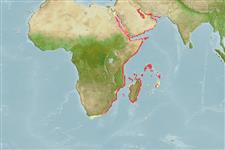Preferred temperature (Ref.
115969): 24.6 - 28.5, mean 27.1 (based on 444 cells).
Phylogenetic diversity index (Ref.
82804): PD
50 = 0.5000 [Uniqueness, from 0.5 = low to 2.0 = high].
Bayesian length-weight: a=0.01445 (0.00856 - 0.02440), b=2.98 (2.83 - 3.13), in cm Total Length, based on LWR estimates for this species & Genus-body shape (Ref.
93245).
Nivel trófico (Ref.
69278): 4.0 ±0.66 se; based on food items.
Resiliencia (Ref.
120179): Bajo, población duplicada en un tiempo mínimo de 4.5-14 años (tm=1.8; K=0.87-0.95; tmax=14).
Fishing Vulnerability (Ref.
59153): Moderate vulnerability (44 of 100).
